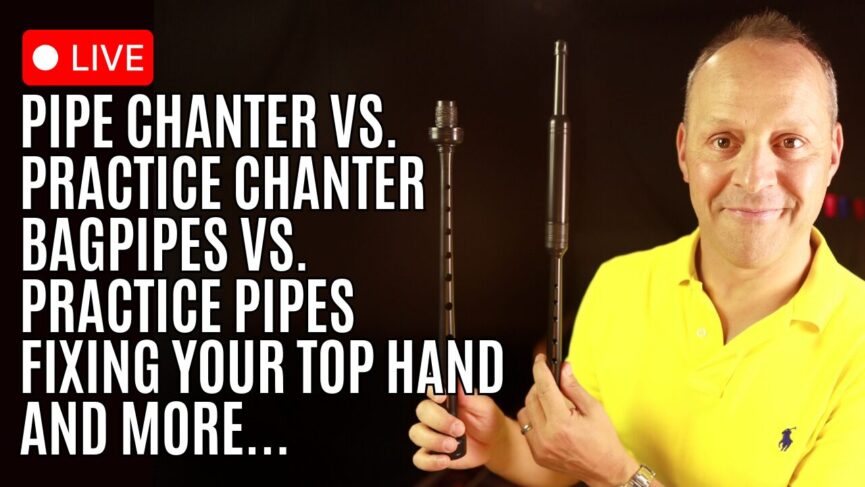
AS FEATURED IN

Super Rare 130 Year-Old Peter Henderson Bagpipes: Unboxing & Dating This One-of-a-Kind Set from 1895
by Jori Chisholm, Founder of BagpipeLessons.com
Last Updated: November 3, 2025
I’m unboxing what might be one of the oldest and coolest sets of pipes I’ve ever had in my hands — a fully ivory-mounted set believed to be Peter Henderson bagpipes from the late 1890s to early 1900s (possibly made by Peter himself). There’s even a 1906 photo of the owner.
In this video, I walk through the unboxing, show the cocus wood (lighter color than African blackwood), point out iconic Henderson projecting mounts, double pinstripe details, and do first mouth-blown tests on both tenor and bass with modern reeds. The initial sound? Classic Henderson tenor focus and that deep, rich bass with a clear “kick” into second tone.
If you love vintage Hendersons (or piping history), you’ll enjoy this one!
Products Mentioned in this Video:
Watch the video and scroll down to read the full video transcript.
Highlights in this video:
-
Historic Find – I unboxed a rare set of Peter Henderson bagpipes, possibly made by the man himself in the late 1890s or early 1900s.
-
Proof of Age – An appraiser dated them 1905–1910, and a 1906 photo labeled “Neil McLean” may show their original owner.
-
Remarkable Condition – The ivory mounts and cocuswood are in stunning shape, with classic Henderson beading and combing still crisp.
-
Authentic Henderson Sound – Even on my first try, the drones had that rich, resonant Henderson tone—smooth, steady, and alive.
-
Original Chanter – The engraved “P. Henderson, Glasgow” chanter completes this rare, nearly untouched vintage set.
Video Transcript: Hey everybody, welcome back to BagpipeLessons.com.
Recently, I’ve been posting some really cool bagpipe unboxing videos, including some of the new bagpipes from Peter Henderson, made by R.G. Hardie & Co. in Scotland. Today, I have something very cool and very special—and very, I think, amazing—to show you.
This is a set of bagpipes. They just arrived today. I have not opened them, and these are not bagpipes that you are going to be able to purchase because… well, we’ll find out.
But these bagpipes—I’m going to open them up, we’re going to check them out, and if we can get them authenticated and dated, if they are what I think they are—these are Peter Henderson bagpipes made by the real Peter Henderson himself.
And I’ll have to double-check the dates, but I think he died before 1905. So these bagpipes may have even been made in the late 1890s, if that’s truly what they are. This is one of the oldest things I’ve ever had in my possession—certainly one of the oldest things in my house.
So, this—we believe—is a photograph of these bagpipes, from 1906. That is pretty amazing. I love these old photographs.
We’ll find out, but this says “Neil McLean, 1906.” I think this was the guy who owned these pipes, if not originally, then at least over 120 years ago—120 years ago or so.
So, here we go. Let’s see what we’ve got. All right. Hopefully these were packed up okay. So, we got a letter here. Okay, I know what this is. This is a letter from an appraiser—1905 to 1910. Full ivory-mounted cocuswood bagpipes made by Peter Henderson, Glasgow. I actually think they’re older than that.
Let’s take a look. So, cocus wood is different than a lot of the—well, stiffer than the wood that is used to make bagpipes these days. We usually use African blackwood.
All right, got a bunch of bubble wrap—get rid of that—and then what we see is…we have very well-packed, individually—that’s what we want to do. These pipes are not ready to play. These are just the pipes themselves. All right, that’s it. So let’s take a look here and see what we’ve got. I’m really excited. I have never owned bagpipes this old. I’ve only seen bagpipes this old from a distance. I’ve never played them. I’ve never really had the chance to look at them up close. This is really amazing.
So, for pipers who know about different vintages of bagpipes and who know what these different vintages are in terms of how they affect the sound—Peter Henderson is… I mean there—Oh my goodness. Look at that. That is amazing. So, first of all, this right here—that is the classic Peter Henderson projecting mount shape. There’s a little bit of, sort of like—well, I don’t have a better word for it than “brown stuff.” I don’t know if this is fuzz or little pieces of leather or what that is, but this is amazing.
And you can see the Schreger lines—which are the… come on now, focus… there we go.
So you can see, you know, if you look at real elephant ivory, you’ll see this cross—sort of cross-grain, cross-hatching pattern—and you can see that very, very clearly. Wow, it’s dark. It’s got this really dark, deep color. There’s a little crack there. And then the other thing that I noticed right away is that the wood is lighter than you would expect from bagpipes that were made out of African blackwood. So, it’s a dark brown, but not really dark—has sort of a reddish color to it.
That is amazing.
If we look in there—wow. So, I think these need to be brushed out. They’re not as reflective, like glass, like I would expect they would be if they were brushed out. So, one of the things that’s going to happen is I’m going to do a refurbishing video—or I’ll do another video after they’ve been put together. And maybe “refurbishing” isn’t the right word.
I’m not going to do anything to alter these pipes, except oil them and maybe brush out the insides of the bores—get out some dust. 100-year-old dust in there. So, I saw these bagpipes just in photographs, and this is my first time seeing them in person.
What have we got here? Great job of packing these pipes individually. If you ever send bagpipes, you want to make sure not only are they in a case or a box that is protected from the outside, but you want to make sure each piece is individually wrapped in bubble wrap so they don’t bang against each other.
Wow, these are very well wrapped. I do not want to get my scissors anywhere close to these pipes either, though. There we go.
Wow. I mean, it—it’s like, this takes my breath away just to see that Henderson mount, that shape. That is so iconic. And you might be thinking, “Well, they look like bagpipes. They look like any other bagpipes.” But to someone who has been around a lot of sets, who has seen and heard these old Henderson sets, that is just amazing to see. That… beautiful again. The deep ivory color—I can definitely see that cross-hatching there. Wow. That is so cool. I’ve got to take some high-res photos of these and share them with you guys.
Okay, so that’s a bass top—or it’s a bass bottom—and a tenor bottom. God, it’s like Christmas. I can’t get these things unwrapped quick enough here. All right, there we go. Wow. Okay, so there we have a tenor top. And what is amazing to me is that these pipes look almost new. Well, they’re used—clearly—but this beading and combing here, it’s in really, really great shape.
It’s got some little nicks that show they’ve been played, but I’ve seen bagpipes that are five years old that look worse than this.
That is really amazing.
So we’ve got the ivory ring cap here, the ivory bushing, and then what you see are these really cool little details—like the little double pinstripe here, the double pinstripe here, and then just below the drone cords here, a little double pinstripe, double pinstripe, double pinstripe.
So I’m going to send some photos of these to a couple people that are experts on old bagpipes and get their input. But to me, these can be a tell—that just below the projecting mount, there’s this, above all the beading and combing. The beads are these little round shiny bits, and then the combing are these little lines. But then there’s two little pinstripes there.
That is amazing. Holy cow. Okay, so this would be a tenor top. There we go. Gosh, do I have any drone reeds here in arm’s reach? Can I replace something? Oh—here’s a tenor. Here’s a, uh, an Ezeedrone. Let’s see how this sounds.
Wow. That’s amazing. That’s a perfect tenor sound—a louder, rougher first tone kicks into that second tone and it focuses. That’s so great. Oh, I can almost feel it thunk and go into that second tone. Oh my gosh, that’s so amazing. So excited. Okay, let’s keep going here. Oh—we got a bass top here.
There it is. Those are not chips. Those are just a little bit of discoloration there. I wonder what we can do to clean those up. Again, the quality is evident in the manufacturing. All this could be 30 years later. And also, these pipes hardly look like they’ve been played. This is fantastic. Sometimes you’ll see on older pipes—especially on the bottom of the bass drone, because this is where it goes on your shoulder—this is all worn out or chipped, or some of these combs are broken. Do not see that at all on here.
So this looks like the middle section of the bass drone. I’m going as fast as I can here. Just amazing. Wow. I love the bass drone middle section because it’s the only section that has this function. You know, we’ve got tops and bottoms, and the bass has the middle section. That is great. So again, we got some little—there we go. Boy, that is amazing. I’m going to grab a drone reed. There we go. Got a drone reed here.
Let’s see how this bass drone sounds. So, this is the Ezeedrone with the increased absorption bass. This is my favorite bass reed. Wow. See, one of the things that you want with a good set of pipes is that when you slide a section on a hemped pin, it’s the same tightness all the way. On some pipes that are defective or were made poorly, the walls on the inside are not straight—so it’ll be tight and then it’ll be loose, or it’ll be loose and then it’ll be tight.
This feels really, really good. That’s amazing. I’m going to open up this reed a little bit. That’s amazing. That’s exactly what we want from that Henderson bass. It’s kind of rough and growly, and then when it kicks into that second tone, it really kicks in—and I can just feel it vibrating in my hands. That’s it. That’s amazing.
Okay, I know I keep saying “amazing.” I don’t have any other words, but these pipes look fantastic. And just on the initial mouth blow that we did—they sound exactly how you want them to sound. Steady and smooth and pure on those tenors, and that really nice resonant bass drone sound—that sounds very steady.
Okay, what do we have here? A blowpipe. This is amazing. This blowpipe doesn’t have a mouthpiece, but that’s fine—that’s replaceable. It’s quite narrow. So, it’s really narrow… can barely get a pencil in there. These days, the blowpipes have a much wider bore, which makes it easier to blow through. The narrower bore protects the blowpipe from cracking, but it’s a little more restrictive.
What’s amazing is that this is the original blowpipe—and there are no cracks. It almost looks like it hasn’t been played. Amazing.
Okay, let’s keep going. Oh—there’s something in here. Looks like… all right, so that’s a… looks like a modern mouthpiece. Plastic mouthpiece. We’ll be replacing that. Okay, what else have we got here? This looks like another… another tenor drone top, right? Again—looking perfect. Just amazing. And it looks like the other tenor drone bottom section. Where would we be without bubble wrap? Another fantastic, beautiful-looking tenor. Have a listen, shall we?
Wow. Again—really, really good. That’s the perfect tenor drone right there. I changed blowing pressure and there is zero change in the pitch of that. And you can really hear that ring—it’s like a high harmonic there. Woo! Fantastic. Well, there’s more to go here. So, this is truly sticks only. When you order a set of bagpipes—if you order sticks only—what you get is the three drones, like we have here, and then the five stocks: Blowpipe stock, Chanter stock, Two tenor drone stocks, Bass drone stock, Blowpipe stock—fantastic. You can see the change in the quality of the wood there—or not the quality of the wood, but sort of the finish towards the bottom, because this has been inside a bag, probably a leather bag, getting a lot of moisture on there. So that’s our blowpipe stock.
And then we’ve got—that’s the shortest one. The next one, slightly longer, is the chanter stock. Interesting. So, chanter stock has a bit of a groove there. I think they sometimes do that—it’s part of the bag tying-in process. Have a little bit of a groove, I guess, for the leather on the sheepskin bag.
Very, very nice. A little bit of wear on there. And it’s just keeping that consistent with this bead and then this little double pinstripe pattern.
Next, we’ve got the two tenor drone stocks. Yep, that one looks good. Got some discoloration on this ivory here. I’m going to research about how to clean this—I don’t want to at all do anything to damage these pipes or the finish, but maybe we can clean them with something that’s just safe. Get to some of the gunk. Okay, here we have another tenor stock. Yep—two tenor stocks, identical.
It’s really amazing how light that wood is. It’s like… this cocus wood. And from what I’ve read about the history of making bagpipes, there was a time before African blackwood—and that was a very hard wood. I have to learn more about the history of it, but I think in the 1910s maybe they switched over to African blackwood.
Wow. And there’s the bass stock. Beautiful. So we got all five stocks. All right—we got our two tenors. Beautiful. Put those down before I drop something. We got our bass drone. This might be…Well, I’m going to get these things set up. There’s going to be a part two to this video. But this might be the most amazing set of pipes, historically, that I have ever played.
I’ve played some really nice new pipes. I’ve never had in my possession and been able to play and really get to know and investigate the sound up close of one of these classic old sets of pipes.
So—that’s it. I got my blowpipe—Oh wait, there’s one more thing here. No way. Is this the chanter? This—I think this is a pipe chanter. This is amazing. So this is a complete set, which is extremely rare, because usually these old sets of pipes that have been played continuously—for example, there are some famous pipers today that play old, old sets of pipes—but almost never do they still have the original chanter. So this—if this is the original chanter—we are in for a treat.
Wow. Look at that. There it is. Oh. Amazing. “P. Henderson, Glasgow”—right there. That is really—“P. Henderson, Glasgow” right at the top. And you see this bell shape—this is really different than the chanters that we have today. The holes are nice and small, nice and close together. And it’s really thick. It’s so thick at the bottom—I wonder how thick the wood is. And then it also has this giant ivory sole that we don’t see too often anymore.
But that’s it. This is really remarkable, because you can see that this chanter has been played. You can see the little bit of wear where the piper’s fingers have gone. But really, I’ve seen some chanters that are maybe 20 years old—obviously from the shape and the ivory, you know it’s really, really old—but the amount of wear on it is hardly any.
This is amazing. This is like finding a really, really old car that’s in almost new condition. So, there he is—Neil Mclean from 1906. We have your pipes here, my man. This is amazing. So we’re going to stay tuned. I’m going to get these things oiled up—well, there’s a couple different steps here for the process. But one is to get them oiled up and cleaned up, and then set up and played.
I’m going to get them—I’m going to get them set up, the drones. And then let’s see what the chanter sounds like as well. Some of these old chanters have a really interesting, different sound than what we’re used to today. But I’m really, really mostly interested in the drone sound.
And then I’m going to take some more pictures, I’m going to email them to a couple of friends who know a lot more about old pipes than I do. And we’ll find out: Are these the real deal? Were these really made by the man himself, Peter Henderson? And can we find out—from the ivory, or from the wood, or from some of these little clues like this double pinstripe pattern below the cord holders, or maybe from the shape of the bell of the chanter or of the sole—can we pinpoint the exact date? So this is a mystery. This is a really fun mystery.
Stay tuned. Thanks for watching. Remember—if you want to find out the true identity of these bagpipes, make sure to subscribe to the channel. Hit the bell to be notified when I post a new video. This is going to be really fun. Join me and stay tuned for Part Two of the Amazing Peter Henderson Bagpipes.
See you next time.
Mahalo.




